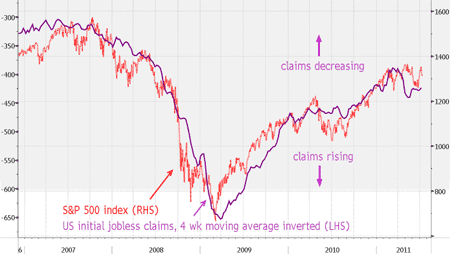Every week, we track what’s going on in the US job market. That’s because employment is key to economic expansion. More Americans at work means extra spending and higher growth. But if US dole queues lengthen, the economy will suffer – and the rest of the world will feel the effects.
The latest figures for US initial jobless claims (IJC) are just out. These show how many Americans are claiming state unemployment benefits for the first time. In particular, the four-week moving average of IJCs, which filters out the weekly ‘noise’, has been a great pointer to future changes in both the US economy and the stock market too.
For the week to 8 July, IJCs fell 22,000 to 405,000. At first glance that looks much better than expected – economists had expected a drop to 420,000. But it’s not that simple. Last week’s figure had been revised up by 9,000.
This means that the four-week moving average dipped only slightly to 423,250 – which was still almost 7% higher than three months before. Meanwhile, the jobless ‘continuing claims’ figure came in almost 50,000 higher than both last time and the economists’ forecasts.
What does this mean for the stock market? Look at the chart:

Source: Bloomberg
(Click on the chart for a larger version)
The purple line is the inverted IJC four-week moving average. The higher this moves on the chart, the fewer claims are being submitted. So a rising purple line is good news, and a falling line bad news.
The red line is the S&P 500 index, the world’s most watched stock market index. The IJC figures forecast its May drop, and also its recent rally, very neatly. The subsequent sideways move in the IJC four-week moving average means the jury is still out on where US stocks are heading next. But there’s every chance that the latest dip will continue.
Category: Economics

